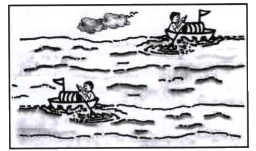A man rows 10km upstream and the same distance downstream. The difference in time taken by the man in rowing upstream and downstream is 5min. If the speed of boat is 35km/hr, what is the speed of the stream?
13 km/hr
5 km/hr
10km/hr
7.5 km/hr
To solve the problem step by step, we will follow these steps:
Step 1: Understand the Problem
We have a man rowing 10 km upstream and 10 km downstream. The difference in time taken for these two journeys is 5 minutes. The speed of the boat is given as 35 km/hr. We need to find the speed of the stream.
Step 2: Define Variables
Let:
- Speed of the boat (x) = 35 km/hr
- Speed of the stream (y) = unknown (to be determined)
Step 3: Calculate Effective Speeds
- Speed upstream = (Speed of boat - Speed of stream) = (x - y) km/hr = (35 - y) km/hr
- Speed downstream = (Speed of boat + Speed of stream) = (x + y) km/hr = (35 + y) km/hr
Step 4: Write Time Equations
Using the formula for time (Time = Distance / Speed), we can write the time taken for upstream and downstream:
- Time taken to row upstream = Distance / Speed upstream = 10 / (35 - y) hours
- Time taken to row downstream = Distance / Speed downstream = 10 / (35 + y) hours
Step 5: Set Up the Equation for Time Difference
According to the problem, the difference in time taken is 5 minutes. We need to convert 5 minutes into hours:
5 minutes = 5/60 = 1/12 hours.
Thus, we can set up the equation:
1035−y−1035+y=112
Step 6: Simplify the Equation
To eliminate the fractions, we can multiply through by the common denominator:
(35−y)(35+y)⋅(1035−y−1035+y)=(35−y)(35+y)⋅112
This simplifies to:
10(35+y)−10(35−y)=(352−y2)12
Step 7: Expand and Simplify
Expanding the left side:
10(35+y−35+y)=20y
Thus, we have:
20y=(352−y2)12
Step 8: Clear the Fraction
Multiply both sides by 12 to eliminate the fraction:
240y=352−y2
Step 9: Rearrange to Form a Quadratic Equation
Rearranging gives:
y2+240y−1225=0
Step 10: Solve the Quadratic Equation
Using the quadratic formula y=−b±√b2−4ac2a:
Here, a=1, b=240, and c=−1225:
y=−240±√2402−4⋅1⋅(−1225)2⋅1
Calculating the discriminant:
=√57600+4900=√62500=250
Now substituting back:
y=−240±2502
Step 11: Calculate Possible Values for y
Calculating the two possible values:
1. y=102=5
2. y=−4902=−245 (not valid since speed cannot be negative)
Conclusion
Thus, the speed of the stream is:
Speed of the stream=5 km/hr
We have a man rowing 10 km upstream and 10 km downstream. The difference in time taken for these two journeys is 5 minutes. The speed of the boat is given as 35 km/hr. We need to find the speed of the stream.
Let:
- Speed of the boat (x) = 35 km/hr
- Speed of the stream (y) = unknown (to be determined)
- Speed upstream = (Speed of boat - Speed of stream) = (x - y) km/hr = (35 - y) km/hr
- Speed downstream = (Speed of boat + Speed of stream) = (x + y) km/hr = (35 + y) km/hr
Using the formula for time (Time = Distance / Speed), we can write the time taken for upstream and downstream:
- Time taken to row upstream = Distance / Speed upstream = 10 / (35 - y) hours
- Time taken to row downstream = Distance / Speed downstream = 10 / (35 + y) hours
According to the problem, the difference in time taken is 5 minutes. We need to convert 5 minutes into hours:
5 minutes = 5/60 = 1/12 hours.
1035−y−1035+y=112
To eliminate the fractions, we can multiply through by the common denominator:
(35−y)(35+y)⋅(1035−y−1035+y)=(35−y)(35+y)⋅112
10(35+y)−10(35−y)=(352−y2)12
Expanding the left side:
10(35+y−35+y)=20y
Thus, we have:
20y=(352−y2)12
Multiply both sides by 12 to eliminate the fraction:
240y=352−y2
Rearranging gives:
y2+240y−1225=0
Using the quadratic formula y=−b±√b2−4ac2a:
Here, a=1, b=240, and c=−1225:
y=−240±√2402−4⋅1⋅(−1225)2⋅1
=√57600+4900=√62500=250
y=−240±2502
Calculating the two possible values:
1. y=102=5
2. y=−4902=−245 (not valid since speed cannot be negative)
Thus, the speed of the stream is:
Speed of the stream=5 km/hr
Similar Questions
A boat takes 10 hours to travel 30 km upstream and 44 km downstream, but it takes 13 hours to travel 40 km upstream and 55 km downstream. Find the speed of the boat in still water and the speed of the stream.
View SolutionA man rows 24 km upstream in 6 hours and a distance of 35 km downstream in 7 hours. Then the speed of the man in still water is
View Solution
Knowledge Check
A man can row 30 km upstream and 44 km downstream in 10 hrs . Also , he can row 40 km upstream and 55 km downstream in 13 hrs . Find the speed of the man in still water .
A5 km/hrB8 km/hrC10 km/hrD12 km/hrA man rows a boat upstream a certain distance and then returns back to the same place. If the time taken by him in going upstream is twice the time taken in rowing downstream, find the ratio of the speed of the boat in still water and the speed of the stream.
A2:1B3:2C5:3D3:1A man can row upstream at 15 km/h and downstream at 21 km/h. The speed of water current of the river is :
A8 km/hB6 km/hC3 km/hD5 km/h
A boat goes 12 km upstream and 40 km downstream in 8 hours. It can go 16 km upstream and 32 km downstream in the same time. Find the speed of the boat in still water and the speed of the stream
View Solution
A boat goes 30km upstream and 44km down stream in 10 hours. In 13 hours, it can go 40km upstream and 55km downstream. If the speed of the boat in still water be x km/h and speed of the stream be y km/h. Then.
Write the speed of the boat towards downstream.
View Solution
A boat goes 30km upstream and 44km down stream in 10 hours. In 13 hours, it can go 40km upstream and 55km downstream. If the speed of the boat in still water be x km/h and speed of the stream be y km/h. Then.
Find the speed d the boat towards upstream.
View SolutionA person can row a distance of one km upstream in ten minutes and downstream in four minutes. What is the speed of the stream ?
View SolutionThe speed of a boat downstream is 15 km/hr and the speed of the stream is 1.5 km/hr. The speed of the boat upstream is -----
View Solution
